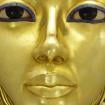
Bes, The Protector Deity: Exuberant Harbinger of Health, Happiness and Vitality – Part II
Few gods achieved the fame that the lion-dwarf Bes managed to garner. He was not only a popular god among the elite in ancient Egypt, but in time was worshipped by people of every strata of society. His unique appeal probably lay in the fact that he was a jovial deity who not only cared for, but was accessible to, the poorest of the poor. As a being who combated evil, along with his counterpart Beset, he proved to be an inalienable part of the lives of the devoted, across cultures and geographies.

Bes was worshipped and invoked by ordinary Egyptians as a protector. His usual depiction, as a grotesque dwarf with a lion's ears and mane, was thought to deter the approach of the malevolent forces believed to cause illness. His image here appears in a bronze statuette made for the unnamed man shown worshipping the god. The harp held by Bes may reflect his power to calm angry spirits. Bronze or copper alloy. Late Period, Dynasty 26–29. Metropolitan Museum of Art, New York.
Sublime Wands and Worship
Even though Bes was originally regarded as a deity who safe-guarded the pharaoh, with the passage of time he came to be increasingly revered by commoners too – so much so that he regularly made an appearance on domestic items such as chairs, headrests, beds, mirrors and ointment jars. He was even painted on the walls of houses. And, in keeping with his ferocious nature, images of Bes were represented on weapons too. Tutankhamun’s tomb also yielded a fair amount of Bes-related objects. But perhaps the most important occurrence of portrayals of Bes were on the ubiquitous magic (apotropaic) wands and amulets which were commonly employed by Egyptian priests and magicians as part of their rituals in casting spells to combat or discourage forces of evil.

Made of faience, this squat human form with leonine features is commonly identified as the god Bes, but several other minor Egyptian gods were also represented by this image. These were protective deities, so they appear frequently as apotropaic figures in the decoration of furniture and personal belongings. Here, the god stands holding the cap of a kohl container. 27th Dynasty, Late Period. Metropolitan Museum of Art, New York.
Apotropaic means something that turns away evil, particularly evil spirits.
Like this Preview and want to read on? You can! JOIN US THERE ( with easy, instant access ) and see what you’re missing!! All Premium articles are available in full, with immediate access.
For the price of a cup of coffee, you get this and all the other great benefits at Ancient Origins Premium. And - each time you support AO Premium, you support independent thought and writing.
Independent researcher and playwright Anand Balaji is an Ancient Origins guest writer and author of Sands of Amarna: End of Akhenaten.
[The author thanks Heidi Kontkanen and Sofia Aziz for granting permission to use their photographs. The public archives of the Metropolitan Museum of Art can be accessed here.]
Top Image: Faience amulet of the head of Bes from the Late Period, 26th to 30th Dynasties. The deity was worshipped and invoked by ordinary Egyptians as a protector against malevolent forces; design by Anand Balaji ( Metropolitan Museum of Art, New York. Deriv)
By Anand Balaji















